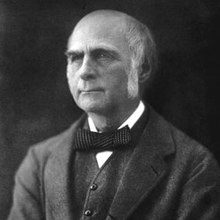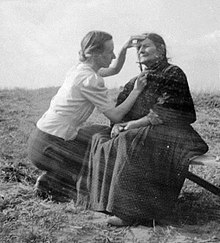Racial hygiene

Racial hygiene was a set of state-sanctioned policies in the early twentieth century by which certain groups of individuals were allowed to procreate and others not, with the expressed purpose of promoting characteristics deemed desirable. The most extensive implementation of such policies occurred in Nazi Germany (Nazi eugenics), but similar policies were implemented throughout Europe, North America, and Southern Africa. [citation needed]
The idea that some races were superior to others emerged in the 19th century. The concept of racial purity was developed by Arthur de Gobineau, who argued that race created culture and that race-mixing leads to chaos. Racial hygiene was historically tied to traditional notions of public health, but usually with an enhanced emphasis on heredity.The states of poverty and sickness were attributed to the individual and not social causes. A poor person was considered lacking in terms of heredity. The kind of medicine that evolved from turning these labels of “degeneration” into scientific categories was known as racial hygiene.[1]
Francis Galton began working in 1869 to find a statistical science of heredity which he believed could encourage voluntary care in selecting partners, and in 1883 he introduced the term "eugenics" for this subject, but in the early 20th century a eugenics movement adopted ideas of Mendelian genetics and promoted negative eugenics to prevent those thought to be unsuitable from having children, and eugenics was used to legitimise policies of racial hygiene.
Origins and History
German social Darwinists felt the need for intervention in what they believed was the degeneration of humans. This desire for intervention was based on their belief that provision of heath care to the lower social ranks and the rapid multiplication of the poor and weak members of society contributed to the corruption of the human race. However, this discussion was not restricted to Germany. British Social Darwinist voiced his opinions on the race problem by saying that diseases such as scrofula and tuberculosis were “our racial friends” because they rid society of the weak of constitution.[2]
Though they have been less covered in scholarly data, eugenics movements in Central and Southeast Europe have received significant analytical effort in recent times. Géza von Hoffman (1885-1921) was a Hungarian eugenicist who wrote “Eugenics in the Central Empires since 1914”, which was a comprehensive analysis of all the eugenic movements in central Europe at the time. American eugenicist Samuel J. Holmes wrote a similar “A Bibliography of Eugenics” that also covered central European movements along with German, French and British movements.[3]
Francis Galton
Francis Galton was a polymath and statistician who coined the term ‘eugenics’, which is the basis of racial medicine. He defined eugenics as “the study of the Agencies under social control, that improve or impair the racial qualities of future generations either physically or mentally.” [4] His father initially forced him to pursue a path of medicine, which he later gave up. Galton was one of the founders of the eugenics movement and a strong proponent of the concept of ‘nature vs nurture’.[5] One of his most lasting contributions to the study of heredity is his theory that race defines a person far more than the person’s environment.[6]
In Germany

The German eugenicist Alfred Ploetz introduced the term Rassenhygiene in his "Racial hygiene basics" (Grundlinien einer Rassenhygiene) in 1895. He discussed the importance of avoiding “counterselective forces” such as war, inbreeding, free healthcare for the poor, alcohol and venereal disease.[3] In its earliest incarnation it was concerned more with the declining birthrate of the German state and the increasing number of mentally ill and disabled people in state-run institutions (and their costs to the state) than with the "Jewish question" and "degeneration of the Nordic race" (Entnordung) which would come to dominate its philosophy in Germany from the 1920s through the second World War.

In Nazi propaganda the term "race" was often interchangeably used to describe and mean the "Aryan" or Germanic "Übermenschen" which was said to represent an ideal and pure master race that was biologically superior to all other races.[7] In the 1930s, under eugenicist Ernst Rüdin, National Socialist ideology embraced this latter use of "racial hygiene", which demanded Aryan racial purity and condemned miscegenation. This belief in the importance of German racial purity often served as the theoretical backbone of Nazi policies of racial superiority and later genocide. These policies began in 1935, when the National Socialists enacted the Nuremberg Laws, which legislated racial purity by forbidding sexual relations and marriages between Aryans and non-Aryans as Rassenschande (racial shame).
A key part of National Socialism was the concept of racial hygiene and during their rule the field was elevated to the primary philosophy of the German medical community, first by activist physicians within the medical profession, particularly amongst psychiatrists. This was later codified and institutionalized during and after the Nazis' rise to power in 1933, during the process of Gleichschaltung (literally, "coordination" or "unification") which streamlined the medical and mental hygiene (mental health) profession into a rigid hierarchy with National Socialist-sanctioned leadership at the top.[8]
The blueprint for Nazism's attitude toward other races was written by Erwin Baur, Fritz Lenz, and Eugen Fischer and published under the title Human Heredity Theory and Racial Hygiene (1936).
Racial Medicine beyond the Nazis
There have been several examples of unethical medical experimentation that has been performed on various groups in Africa, which acted as a precursor to the holocaust. An example of this medical experimentation on African prisoners of war was in concentration camps in Namibia during the Herero and Namaqua Genocide. German South West Africa was a German colony. Sterilization experiments were conducted on Herero women who were the offspring of mixed race to gather evidence to ban interracial marriages.[9] Another instance of this sort of experimentation is when Centers for Disease Control (CDC), World health organization (WHO) and the National Institutes of Health (NIH) funded a project that tested a drug that prevents mother-to-child transmission of HIV/AIDS on 17000 women in Zimbabwe (1994). The test subjects were not informed that a lot of them would be receiving placebo, which led to the transmission of HIV to around 1000 babies.[10]
There has been a strong history of unethical American intervention into the medical communities of other countries. Dr. Richard Strong was the director of the Biological Laboratory of the Philippine Bureau of Science. His experiments with cholera on the prisoners of Bilibed, Manila led to the death of 13 people. The Governor of Philadelphia later granted permission to infect prisoners sentence to die with the plague. The test subjects were not asked for consent.[11]
Tuskegee Syphilis Experiment
Originally known as the “Untreated Syphilis in the Male Negro”, the Tuskegee study (1932-1972) was experiment conducted by the United States Public Health Service (PHS) on African American males who had been diagnosed with non-infectious Syphilis in Tuskegee, Alabama. The subjects were led to believe that they would receive treatment in the form of drugs and spinal taps, but were not given any form of medical intervention. The subjects believed that they suffered from an ambiguous condition called “bad blood”, and were not treated with penicillin even when it was scientifically proven to be the ideal treatment for syphilis. Today, Tuskegee is an example of deception, lack of informed consent, failure to grant autonomy, and racism and scientific hubris.[12] It is believed that the African American community faith in public health efforts has been diminished since the unethical and racist details of the study were released.[13]
After World War II
After World War II, the racialist ideology was denounced as unscientific and pseudoscience by many,[2] although there continued to be supporters and enforcers of eugenics even after there was widespread awareness of the Nazi debacle. Post 1945 eugenics proponents include Julian Huxley and Dr. Marie Stopes.[14]
Modern Racial Medicine
A prominent example of medications targeted to a specific race is the case of Bidil. A group of 1050 African Americans with congestive heart failure participated in a 3-year study called African American Heart Failure Trial (A-HeFT), in which they were treated with Bidil i.e. isosorbide dinitrate and hydralazine. This was the first “racial drug” in medical practice. [15] The control group was treated with their usual heart medications. The results showed that “BiDil users had a 43% better survival rate during the course of the study and were 39% less likely to need hospitalization for HF”.[16]
See also
- Action T4
- Endogamy
- Ethnic cleansing
- Eugenics in Japan
- Eugenics in the United States
- Euthanasia
- Genetic pollution, a controversial term because of its similar connotations
- Mental hygiene
- Miscegenation (in humans), Outcrossing (in non-human organisms)
- Pure blood theory in Korea
- Purebred
- Racial policy of Nazi Germany
- Race (human classification)
- Race of the future - a theoretical composite world race which will result from ongoing racial admixture
- Rassenschande
- White supremacy
References
- ^ Götz, Aly (1994). Cleansing the Fatherland: Nazi Medicine and Racial Hygiene. Baltimore: Johns Hopkins University Press.
- ^ a b Wentz S, Proctor RN, Weiss SF (1989). "Racial hygiene: the pseudo-science of Nazi medicine". Medical Humanities Review. 3 (1): 13–8. PMID 11621731.
- ^ a b Turda, Marius; Weindling, Paul (2007). Blood and Homeland": Eugenics and Racial Nationalism In Central and Southeast Europe, 1900-1940. Budapest: Central European University Press. p. 1.
- ^ "Francis Galton's definition of eugenics :: DNA Learning Center". www.dnalc.org. Retrieved 2017-04-19.
- ^ Proceedings. 1875-01-01.
- ^ Comfort, Nathaniel (2012). The Science of Human Perfection: How Genes Became the Heart of American Medicine. Yale University Press.
- ^ Peter Longerich (15 April 2010). Holocaust: The Nazi Persecution and Murder of the Jews. Oxford University Press. p. 30. ISBN 978-0-19-280436-5.
- ^ Herzog, Dagmar (2005). Sexuality and German Fascism. Berghahn Books. p. 167.
- ^ Harriet, Washington (2006). Medical Apartheid.
- ^ Meier, Benjamin Mason. "International Protection of Persons Undergoing Medical Experimentation: Protecting the Right of Informed Consent". Berkeley Journal of International Law.
- ^ Strong, Richard. "Vaccination Against Plague". Philippine Journal of Science.
- ^ Reverby, Susan M. (2010-08-01). "Invoking "Tuskegee": problems in health disparities, genetic assumptions, and history". Journal of Health Care for the Poor and Underserved. 21 (3 Suppl): 26–34. doi:10.1353/hpu.0.0354. ISSN 1548-6869. PMID 20675943.
- ^ Alsan, Marcella; Wanamaker, Marianne (2016-06-01). "Tuskegee and the Health of Black Men".
{{cite journal}}: Cite journal requires|journal=(help) - ^ Rose, June (1993). Marie Stopes and the Sexual Revolution. London: Faber and Faber. p. 244.
- ^ Duster, Troy (2005-01-01). "Race and Reification in Science". Science. 307 (5712): 1050–1051.
- ^ "About BiDil (isosorbide dinitrate/hydralazine HCl) for Heart Failure". www.bidil.com. Retrieved 2017-04-19.
{{cite web}}: no-break space character in|title=at position 12 (help)
Further reading
- Glad, John. (2008). Future Human Evolution: Eugenics in the Twenty-First Century. Hermitage Publishers.
- Joseph, J. (2004). The Gene Illusion: Genetic Research in Psychiatry and Psychology Under the Microscope. New York: Algora. (2003 United Kingdom Edition by PCCS Books)
- Joseph, J. (2006). The Missing Gene: Psychiatry, Heredity, and the Fruitless Search for Genes. New York: Algora.
- Paul, Diane B. Controlling Human Heredity, 1865 to the Present. New Jersey: Humanities Press, 1995.
- Proctor, Robert. Racial Hygiene: Medicine Under the Nazis. Cambridge, Mass.: Harvard University Press, 1988.
